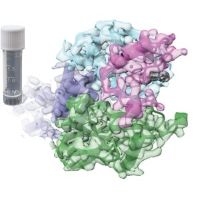Specification
| Description | Recombinant protein from the full-length sequence of Homo sapiens carboxypeptidase Q (CPQ) (NM_016134). |
| Organism | Homo sapiens (Human) |
| Expression Host | Human Cells |
| Tag Info | His or DYKDDDDK. Please contact us if you need further information or require specific designed tag. |
| Purity | Greater than 90% by SDS-PAGE gel |
| Uniprot ID | Q9Y646 |
| Entry Name | CBPQ_HUMAN |
| Gene Names | CPQ LCH1 PGCP |
| Alternative Gene Names | LCH1 PGCP |
| Alternative Protein Names | Carboxypeptidase Q (EC 3.4.17.-) (Lysosomal dipeptidase) (Plasma glutamate carboxypeptidase) |
| Application | Antigens, Western, ELISA and other in vitro binding or in vivo functional assays, and protein-protein interaction studies; For research & development use only! |
| Buffer | Purified protein formulated in a sterile solution of PBS buffer, pH7.2, without any preservatives |
| Endotoxin | Endotoxin level is < 0.1 ng/µg of protein (<1EU /µg) |
| Length | 472 |
| Molecular Weight(Da) | 51888 |
| Protein Sequence | (The sequence of expressed protein may have some variation from the sequence shown below. Please contact us for the exact sequence.) MKFLIFAFFGGVHLLSLCSGKAICKNGISKRTFEEIKEEIASCGDVAKAIINLAVYGKAQNRSYERLALLVDTVGPRLSGSKNLEKAIQIMYQNLQQDGLEKVHLEPVRIPHWERGEESAVMLEPRIHKIAILGLGSSIGTPPEGITAEVLVVTSFDELQRRASEARGKIVVYNQPYINYSRTVQYRTQGAVEAAKVGALASLIRSVASFSIYSPHTGIQEYQDGVPKIPTACITVEDAEMMSRMASHGIKIVIQLKMGAKTYPDTDSFNTVAEITGSKYPEQVVLVSGHLDSWDVGQGAMDDGGGAFISWEALSLIKDLGLRPKRTLRLVLWTAEEQGGVGAFQYYQLHKVNISNYSLVMESDAGTFLPTGLQFTGSEKARAIMEEVMSLLQPLNITQVLSHGEGTDINFWIQAGVPGASLLDDLYKYFFFHHSHGDTMTVMDPKQMNVAAAVWAVVSYVVADMEEMLPRS |
Background
| Function | FUNCTION: Carboxypeptidase that may play an important role in the hydrolysis of circulating peptides. Catalyzes the hydrolysis of dipeptides with unsubstituted terminals into amino acids. May play a role in the liberation of thyroxine hormone from its thyroglobulin (Tg) precursor. |
| Pathway | |
| Protein Families | Peptidase M28 family |
| Tissue Specificity | Mainly detected in blood plasma. Abundant in placenta and kidney. Present at low level in muscles, liver and skin fibroblasts. Not detected in brain or white blood cells (at protein level). {ECO:0000269|PubMed:10206990}. |
QC Data
| Note | Please contact us for QC Data |
| Product Image (Reference Only) |  |

